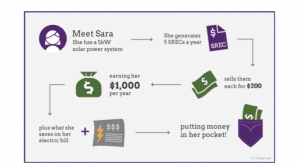5 States with the Best Solar Panel Installation Incentives
Are you wondering if your state is on the list of the top solar supporters? Or are you considering such factors in an upcoming move?
In addition to incentive programs that offer grants or loans, it’s important to look at how quickly you can recoup your costs by selling energy to the grid. To track which states offer the best solar incentives, experts often look at the payback period – the amount of time it takes to recoup the cost of investment by producing energy.
Across the U.S., the average payback period is just under eight years, says EnergySage, which provides an overview of state payback periods.
New Jersey
The Garden State has an average payback period of 5.5 years – for two main reasons. First, electricity prices are fairly high, so solar installation owners can make money back quickly by selling energy to the grid. Second, the state has a strong solar renewable energy certificates (SRECs) program, which means residents can receive a competitive payment for that energy.

Massachusetts
Tied with the Garden State, a Massachusetts solar panel installation can typically recoup its upfront costs in 5.5 years. The Bay State offers a great residential solar tax credit for installing panels. Further, Massachusetts’ SMART program provides fantastic performance-based incentives.
California
Homeowners in the Golden State can receive financing for a new solar installation through the Home Energy Renovation Opportunity (HERO) Financing Program. Additionally, many localities in the state offer strong incentive programs for residents, like Sonoma County’s Energy Independence Program.
Moreover, the Disadvantaged Communities Single-Family Solar Homes (DAC-SASH) program, scheduled to run through 2030, provides excellent solar incentives for people living in the most disadvantaged communities in the state.
South Carolina
The Palmetto State offers a great tax credit for solar installations – homeowners can claim 25% of their costs as a tax credit. Utilities in the state offer strong rebates as well. Duke Energy Progress, Santee Cooper, and South Carolina Electric & Gas all run such programs, says EnergySage.
Rhode Island
The Ocean State offers a competitive rebate program for small-scale solar installations, as well as a strong net metering policy (allowing them to sell energy to the grid) and participation in the National Grid’s Renewable Energy Growth Program.
Meanwhile, the states that have installed the highest solar capacity thus far include California, North Carolina, Arizona, Nevada, Texas, New Jersey, Massachusetts, and Florida, in that order.
Environment America offers a report on the cities with the best solar incentives – you might benefit from investigating local programs specific to your own city. You can also take advantage of the federal investment tax credit for solar.
The Solar Energy Industries Association offers a helpful map that displays solar initiatives in different states. The Database of State Incentives for Renewables and Efficiency (DSIRE) also provides a map and an easy-to-search database. Click on your state to learn about the solar resources it provides. As you explore the map, you’ll find more specific incentives that are available to you.
Updated on



